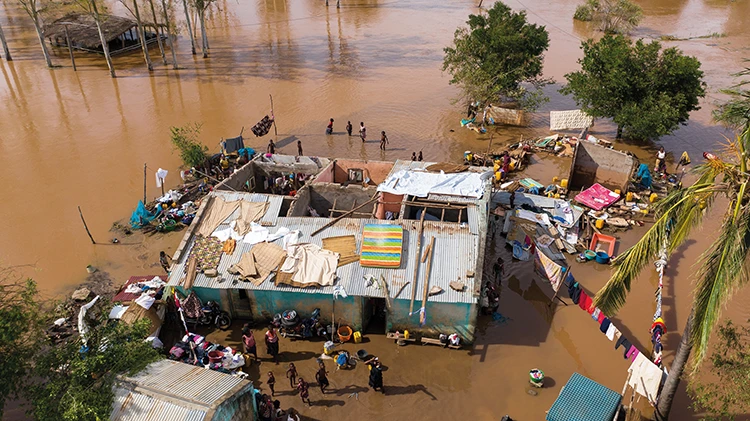
Across sub-Saharan Africa, cities are embracing nature-based solutions to climate change. A World Bank report reveals the keys to their success
In the night of 14 March, 2019, Cyclone Idai made landfall in Beira, the capital of Mozambique. Winds of up to 230 kilometres per hour tore through buildings and flattened neighbourhoods, and storm surges more than four metres high left large areas of the coastal city – home to half a million people – under water. Beyond the city suburbs, many rural families found their food and livestock had been swept away, along with their personal possessions.
Mozambique’s location on Africa’s southeast coast places it in the path of tropical cyclones, which surge across the Indian Ocean to its low-lying shoreline. Less than a month after Idai, Cyclone Kenneth – the strongest tropical cyclone to make landfall in Mozambique since modern records began – struck the north of the country. ‘More than 1.7 million people were affected by both extreme weather events,’ says Mark Lundell, World Bank country director, ‘with damages and losses amounting to US$3 billion.’
More than 60 per cent of Mozambique’s population lives in low-lying coastal areas such as Beira, which has built up around the confluence of a major river system. The city has always been at high risk of flooding, but climate change is now amplifying the destructive force of torrential rains and tropical cyclones. With rapid urbanisation expected to double the city’s size within the next 10–15 years, placing further strain on infrastructure and services, the Cities and Climate Change Project (3CP) was launched in 2012 to address one of the key challenges: the Chiveve River.

This 3.5-kilometre tidal river, which traverses Beira’s central business district and runs from the city’s fishing port to its low-income inland neighbourhoods, once served as a natural flood buffer. By the 2010s, however, much of its mangroves and riverbank vegetation were lost, the river itself cut off from its natural tidal flow and clogged by waste. The city’s master plan focused on wetland restoration, with additional engineered drainage channels alongside the river, and the development of new, green space (including a 17-hectare urban park) that would create additional drainage capacity. ‘Our green infrastructure project will transform Beira,’ Daviz Simango, the city’s former mayor, said in 2018. ‘We will plant over 7,000 trees, establish a botanical garden, re-establish mangroves […] This is arguably the largest green infrastructure in the region.’
The 3CP project represents a growing trend across sub-Saharan Africa in which nature-based solutions – from restoring vegetation to reduce landslide risk to green roofs and corridors that keep urban spaces cool – are increasingly being adopted to combat the impact of climate change. A new report by the World Resources Institute (WRI) and the World Bank, which looked at 297 such projects that have been implemented over the past decade, reveals a 15 per cent increase in new nature-based-solutions projects between 2012 and 2021. More than 75 per cent were large-scale initiatives, costing between US$1 million and US$500 million.

According to the report’s authors, these projects demonstrate how nature-based solutions can serve as a comprehensive strategy for urban development and climate adaptation. Most incorporated a range of climate-mitigation strategies, from improving water resources and reducing hazards to mitigating urban heat. Crucially, they also generated broader benefits; more than half aimed to create jobs and boost livelihoods, while others prioritised biodiversity, health and food security. In Beira, the 3CP project now protects an estimated 50,000 people from recurrent flooding, but it has also created more than 1,200 jobs, revitalised local businesses and improved community health by providing accessible green space and cleaner air.
For nature-based initiatives to succeed long-term, however, collaboration is key. In Beira, local communities were involved in the project from the outset, assisting with mangrove restoration and taking responsibility for river clean-ups. Waste-collection programmes were established in the city’s informal settlements and outreach campaigns helped to raise awareness about the importance of a healthy river and its role in mitigating urban flooding.
Related reads:
Despite the positive results outlined, the report stresses that scaling nature-based solutions for climate adaptation, particularly in cities, remains a major challenge. Current policies and funding heavily favour grey infrastructure, limiting the potential of green–grey approaches – something the report authors say must urgently change.
‘We often think of infrastructure in terms of roads, bridges and buildings – just concrete and steel structures,’ says WRI president and CEO Ani Dasgupta. ‘But nature – forests, trees, wetlands, coral reefs – is just as vital. It supplies clean water, protects communities from disasters and strengthens resilience. Across Africa, cities and communities are proving that green and grey infrastructure can work together to maximise benefits for people, nature and climate – and the world should take note.’



